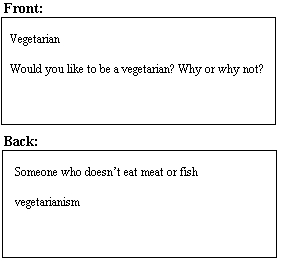
QUICK GUIDE
Key Words:Vocabulary, conversation
Learner English Level: False beginner to advanced
Learner Maturity Level: Junior high school to adult
Preparation Time: None for instructor; 30 minutes homework for students
Activity Time: 20-30 minutes; also 20 minutes for optionally dealing with errors in another class session
Materials: None for instructor; blank vocabulary cards for students
The following activity is primarily designed for productive practice of target vocabulary and expressions. It also provides an excellent context for students to review question formation, express opinions, and hold short conversations.
Step 1: From a class list of at least 20 terms and phrases, ask each student to make five to seven vocabulary cards for homework. A target word or phrase and an open-ended question in which it is used should be written on the front of each card. (Because students will later ask each other these questions in class, use of individualized vocabulary lists is inappropriate for this activity.) The questions should be appropriate for small group discussion, so they should focus on eliciting details of events in classmates' lives, or their opinions. When doing this activity with a class for the first time, brainstorm examples of appropriate and inappropriate questions based on these criteria. The back of each card is for students' personal use and might be used for noting such features as meaning, usage, or part of speech; it may also be left blank. Encourage students to modify this information as their understanding evolves over time. This can be done in students' preferred language.

Step 2: In a subsequent class, students work in groups of three or four, taking turns asking each other the questions on their cards. Prior to the activity, teachers can encourage natural conversation style by instructing students to look at the question they have written, remember the gist of it, put the card aside, and finally ask the question while making appropriate eye contact with group members, and paying attention to natural intonation, rhythm, and stress. All group members should then be given a chance to answer each question, including the person who asked it. Optionally, to encourage natural discussion, provide a sample dialogue like the one below.
Sample Dialogue:
A: Would you like to be a vegetarian?
B: Not really.
A: Why not?
B: I like meat too much!
C: Me, too. And I don't think you can get enough protein without meat.
D: Actually, my friend is a vegetarian. She says it's really not that hard to get enough protein.
C: What about you, A? What do you think of vegetarianism?
A: I think it might be interesting to try.
Step 3: While students are conversing, the instructor should visit each group and act as a model by joining the conversation. The teacher might also note recurring errors as well as student successes and discuss them with the class at the end of the activity.
Step 4: Optionally, to provide feedback for students' written work, collect the cards and mark errors, awkward usage, etc., with a highlighter. In a subsequent class, pass the cards back to students and have them work in pairs to edit up to 10 of their questions on a separate sheet of paper to hand in. This provides students with a choice of errors to address, a cooperative setting in which to work, access to teacher assistance, and a repeated meaningful encounter with target vocabulary.
When considering classroom activities, ESL instructors should aim to foster linguistic development in terms of communicative competency as well as grammatical accuracy. The activity described above provides a context for student development in both of these areas. This activity also provides a natural setting for students to try increasingly complex structures, leading to teaching opportunities. For instance, if a student writes, "What do you think about * so many people protested in the 60s?" the teacher could introduce the fact that to front an independent clause. Finally, repeated use of this activity provides an ideal context to work on communication strategies, such as asking for clarification or repetition, using fillers or hesitation devices, and politely disagreeing.